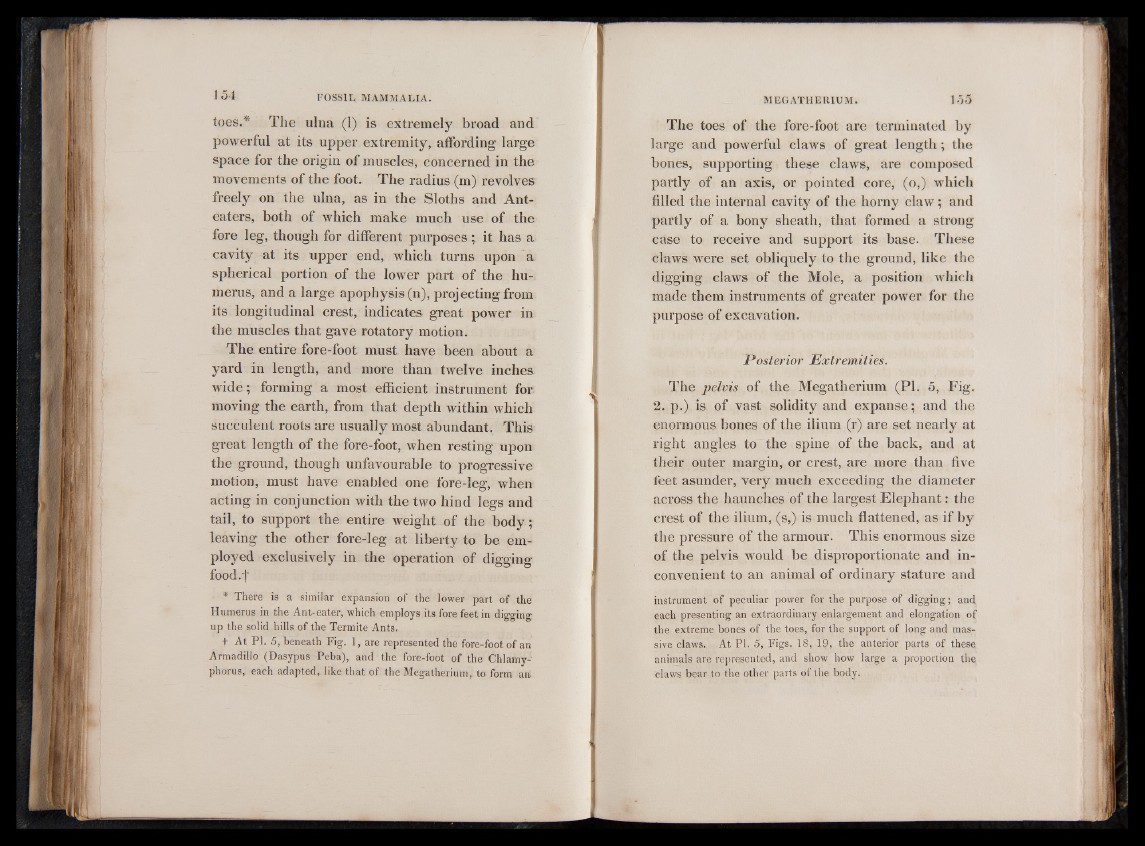
toes.* The ulna (1) is extremely broad and
powerful at its upper extremity, affording large
space for the origin of muscles, concerned in the
movements of the foot. The radius (m) revolves
freely on the ulna, as in the Sloths and Ant-
eaters, both of which make much use of the
fore leg, though for different purposes ; it has a
cavity at its upper end, which turns upon a
spherical portion of the lower part of the hu-.
merus, and a large apophysis (n), projecting from
its longitudinal crest, indicates great power in
the muscles that gave rotatory motion.
The entire fore-foot must have been about a
yard in length, and more than twelve inches
wide; forming a most efficient instrument for
moving the earth, from that depth within which
succulent roots are usually most abundant. This
great length of the fore-foot, when resting upon
the ground, though unfavourable to progressive
motion, must have enabled one fore-leg, when
acting in conjunction with the two hind legs and
tail, to support the entire weight of the body;
leaving the other fore-leg at liberty to be employed
exclusively in the operation of digging
food.j'
* There is a similar expansion of the lower part of the
Humerus in the Ant-eater, which employs its fore feet in digging
up the solid hills of the Termite Ants.
+ At PI. 5, beneath Fig. 1, are represented the fore-foot of an
Armadillo (Dasypus Peba), and the fore-foot of the Chlamy-
phorus, each adapted, like that of the Megatherium, to form an
The toes of the fore-foot are terminated by
large and powerful claws of great length; the
bones, supporting these claws, are composed
partly of an axis, or pointed core, (o,) which
filled the internal cavity of the horny claw; and
partly of a bony sheath, that formed a strong
case to receive and support its base. These
claws were set obliquely to the ground, like the
digging claws of the Mole, a position which
made them instruments of greater power for the
purpose of excavation.
Posterior Extremities.
The pelvis of the Megatherium (PI. 5, Fig.
2 . p.) is of vast solidity and expanse; and the
enormous bones of the ilium (r) are set nearly at
right angles to the spine of the back, and at
their outer margin, or crest, are more than five
feet asunder, very much exceeding the diameter
across the haunches of the largest Elephant: the
crest of the ilium, (s,) is much flattened, as if by
the pressure of the armour. This enormous size
of the pelvis would be disproportionate and inconvenient
to an animal of ordinary stature and
instrument of peculiar power for the purpose of digging; and
each presenting an extraordinary enlargement and elongation of
the extreme bones of the toes, for the support of long and massive
claws. At PI. 5, Figs. 18, 19, the anterior parts of these
animals are represented, and show how large a proportion the
claws bear to the other parts of the body.